One of the unique parts about riding an electric motorcycle is the lack of theatrics, as there is very little in the way of noise and vibration. But not every motorcyclist is down with silently zipping around. For those people, Yamaha has cooked up a wild solution. The motorcycle builder and musical instrument crafter has come up with a functional, but fake “engine” to place inside electric motorcycles that vibrates and makes noise, just like your gas-powered hog does.
There is a somewhat recent trend out there of manufacturers trying to make their electric vehicles feel closer to ones powered by internal combustion, but without the downsides of having an actual ICE powertrain. Nowadays, you can buy an electric Dodge Charger with a fake exhaust that’s so loud it breaks exhaust sound ordinances. Meanwhile, the Hyundai Ioniq 5 N simulates the shifting of a real transmission and adds fake engine noises on top of that. Many EVs and some hybrids pipe in some sort of alien “engine note” through their interior speakers.
The electric motorcycle industry has largely avoided these features, and I think it’s for the better. There is something tranquil about riding an electric motorcycle through a scenic area, and you’re entirely unburdened by sound or vibration. You can just enjoy the world around you, taking in the sights and smells without any sort of distraction. One of the greatest parts of my one-and-a-half-year test of a Zero DSR/X was simply the fact that I got nearly three thousand miles of peace and quiet. If I rode the DSR/X through a forest, there wasn’t the sound of a roaring engine, but only the sound of my tires cracking sticks and crackling through fallen leaves. I have never been more immersed in nature while operating a vehicle.

Even when Harley-Davidson launched the original LiveWire, it didn’t give the bike fake engine noises, but used straight-cut gears to create a distinctive sound. Fake engine sounds are so weird in the electric motorcycle world that Royal Enfield’s April Fools 2025 joke was a press release suggesting its new Flying Flea will have a noise and vibration generator.
The only electric motorcycle that I can think of that fakes vibrations and noise is the Emula One from Italian startup 2electron S.r.l. (pictured above), which also has a simulated transmission and clutch. So, the fact that Yamaha is apparently looking into this technology is pretty big.
A Fake Functional Engine
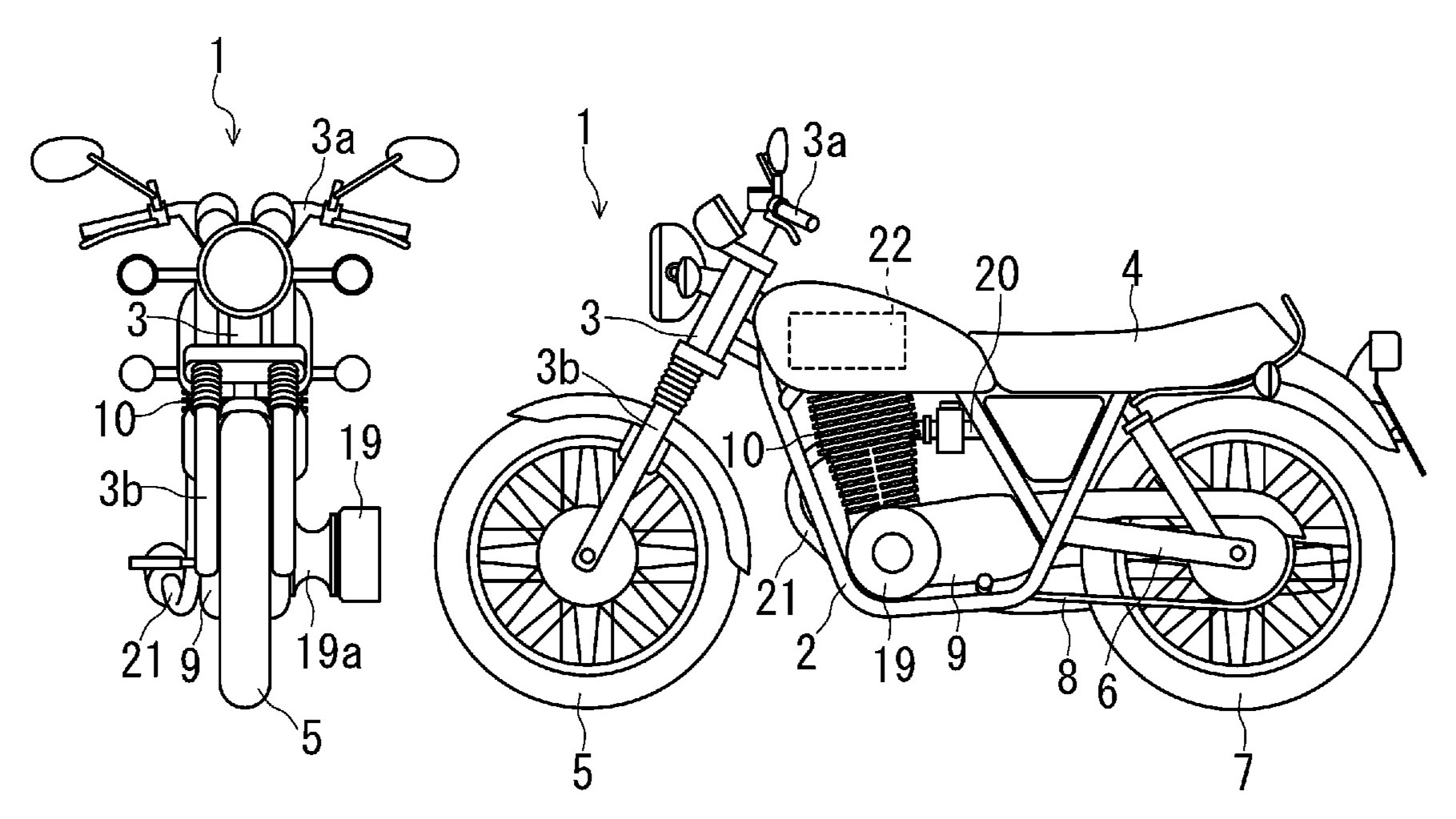
This story comes to us from our friends at RideApart, but I also dug into the patent for myself to see what Yamaha was thinking about here. It’s somehow wilder than you’d think. The patent, publication number WO/2025/191637, opens with a banger:
A four-stroke reciprocating engine generates power by burning a mixture of air and fossil fuel such as gasoline in its cylinders, producing intake noise, exhaust noise, vibrations, etc. during each of the intake, compression, explosion, and exhaust strokes. Drivers of saddle-type vehicles powered by a reciprocating engine feel a sense of excitement when they experience the sounds and vibrations that occur in response to their accelerator operation.
On the other hand, saddle-type electric vehicles, which use a motor as a power source, do not burn gasoline or the like, and therefore do not produce the intake noise, exhaust noise, vibration, etc. that conventional reciprocating engines produce. Therefore, while some saddle-type vehicle enthusiasts support the reduction of carbon dioxide emissions, they have desired to drive a saddle-type vehicle that allows them to experience the unique sounds and vibrations of a reciprocating engine.
Therefore, a vehicle drive motor that has an appearance similar to that of a conventional reciprocating engine has been disclosed. The vehicle drive motor described in Patent Document 1 rotates a crankshaft by reciprocating a piston (linear motor slider) in a cylinder using a linear motor. The vehicle drive motor is configured to take in air through an intake valve and exhaust air through an exhaust valve as the piston reciprocates.

It should be noted that this patent was originally filed in Japanese; that’s why the English is a bit awkward. However, your eyes do not deceive you. Yamaha’s engineers really crafted a functional “engine” that doesn’t really serve a real purpose. If you continue to read the patent, Yamaha says the fake engine has a crankshaft, a cylinder, a piston, and valves. The quasi-engine, while not burning any fuel, even has a compression and exhaust stroke. Apparently, the entire purpose of this engine is to make noise and vibrate.
Yamaha then notes that the engine is powered by the electric motor of the motorcycle, which means that there is some power loss during the fake engine’s compression stroke. Yes, adding a “functional” engine to an electric motorcycle actually makes it slower. So, Yamaha says that its engineers went through quite a process to reduce said power loss. The image below shows the coupler between the electric motor and the crankshaft:

If you squint really hard, you might see some Yamaha SR400 in the motorcycle in the patent design:

The patent explains that the fake engine has the typical ICE four strokes, and then points out which strokes the noise will be coming from:
The saddle-type electric vehicle of the present application is not equipped with a reciprocating engine, but is configured as an electric vehicle in which the power of the motor is transmitted to the drive wheels by rotating a crankshaft about an axis line by the motor. In the saddle-type electric vehicle, the power of the motor is transmitted to the drive wheels via the crankshaft, and the piston in the cylinder is reciprocated by the crankshaft.
The saddle-type electric vehicle draws outside air into the cylinder through at least an intake port during a second stroke, which corresponds to the intake stroke of a reciprocating engine. That is, the saddle-type electric vehicle generates an intake noise at least once during the second stroke during four cycles from the first stroke to the fourth stroke. The straddle-type electric vehicle exhausts air from the cylinder to the outside through at least the exhaust port during a first stroke corresponding to the exhaust stroke of a reciprocating engine and a third stroke corresponding to the compression stroke of the reciprocating engine, generating an exhaust sound.
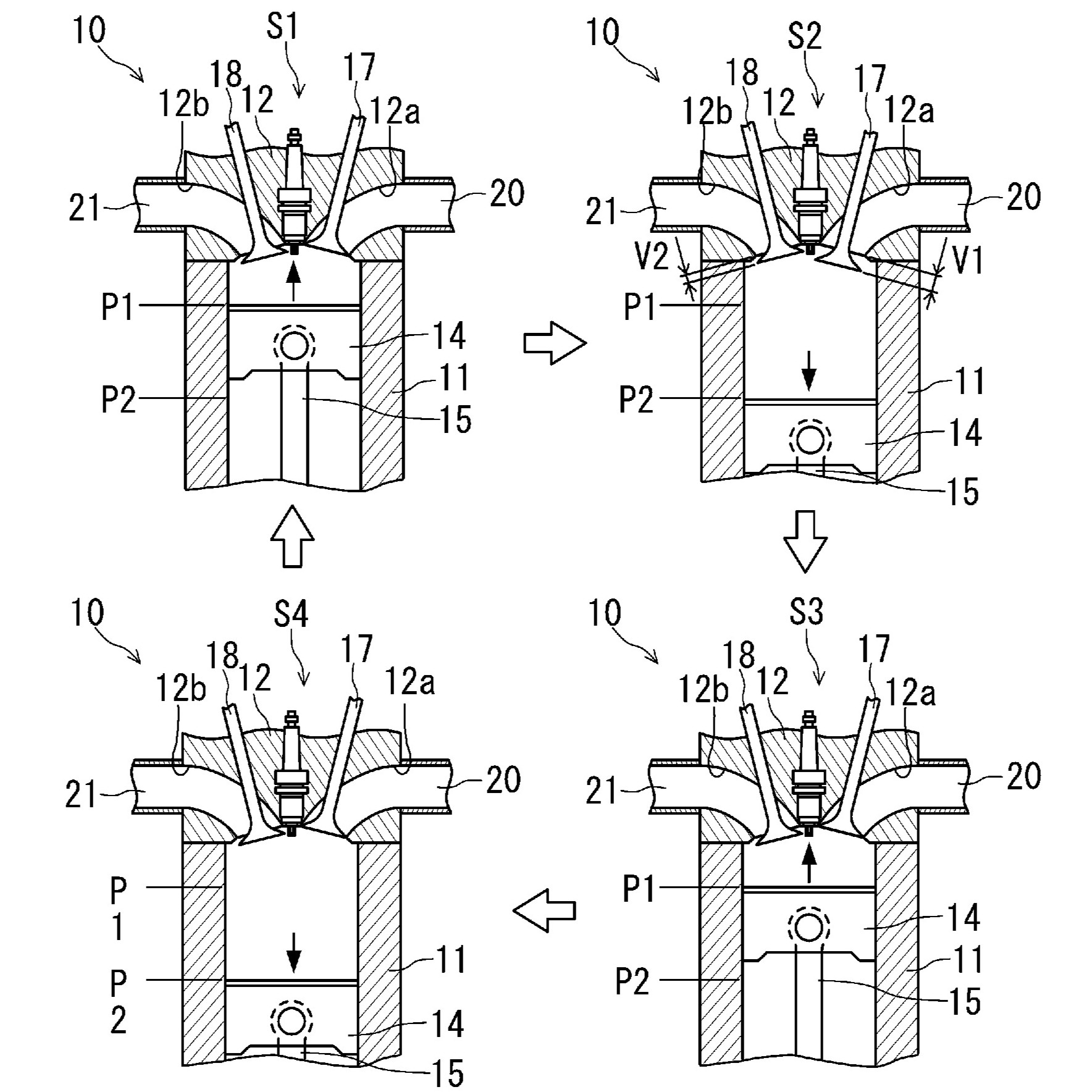
Yamaha clarifies that the fake engine has nearly all of the components of a four-stroke internal combustion engine, but it doesn’t generate any power.
In a typical four-stroke engine, gases are exhausted in the fourth stroke after the combustion stroke. In this engine, Yamaha says, the air exhausts out of the exhaust port during “at least” the first and third strokes. However, as the patent notes above, apparently, the engine can also just leave the exhaust port open during all strokes. These measures reduce the power loss to the electric motor. Yamaha says that the motions of the fake engine create the vibrations.
One more interesting note from the patent is that Yamaha says that the fake engine can be connected or disconnected from the motor using a clutch and a start switch. So, in this bizarre future motorcycle patent, it’s possible to disable the fake engine.
But Why?
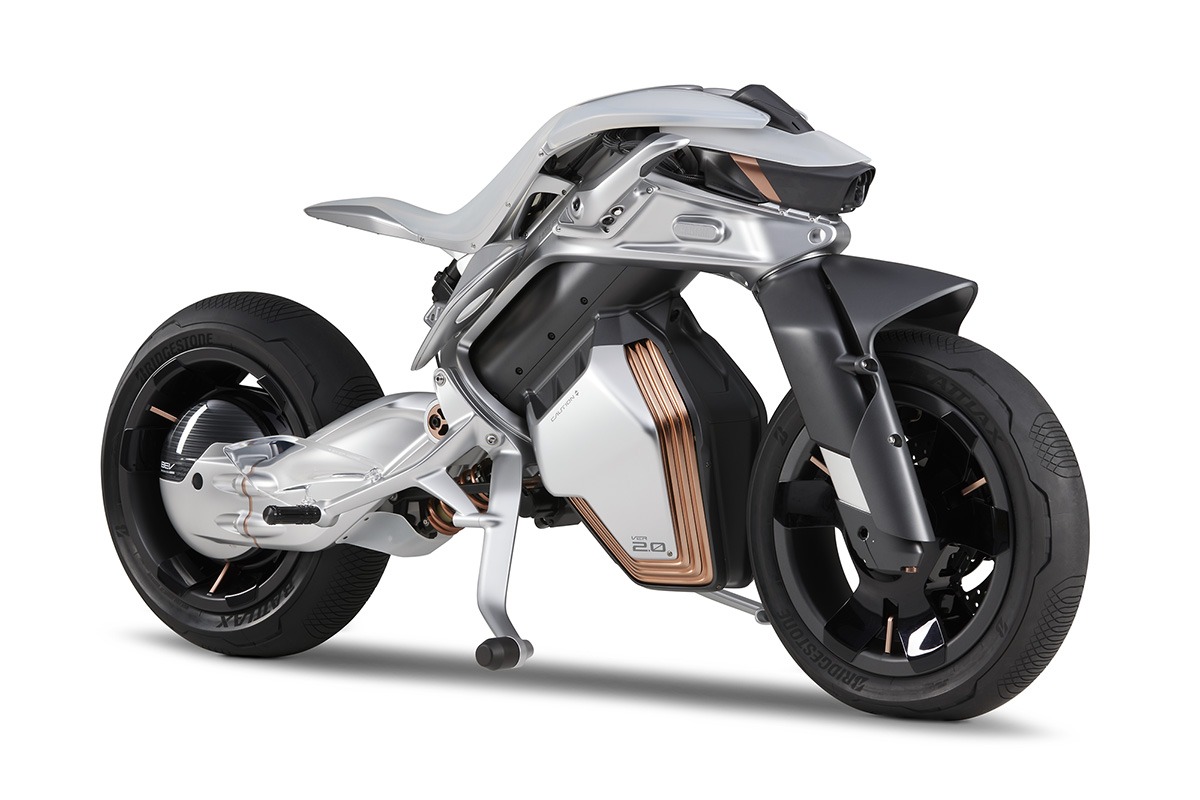
What’s blowing my mind here is that there is precedent for giving an EV fake engine sounds and vibrations. Pretty much everyone else has used a combination of speakers and subwoofers to give the sound and feel of an ICE in an EV. Yamaha decided to take the most insane way to achieve the same result by making a real engine that does a whole lot of nothing. The patent images even show what appears to be air cooling fins, which is just too hilarious.
Now, I will say that Yamaha has not announced any sort of production motorcycle based on this design. As it is, Yamaha has been teasing all sorts of weird electric motorcycles, including the Motoroid 2 pictured above, but never puts any of them into production. Also, it is pretty common for patents to go absolutely nowhere.
[Ed Note: If you’ve ever cranked a gasoline engine for an extended period, you know that the pumping sound/vibration of a piston engine is unique, but without combustion, you have to wonder if this will sound close enough to fool anyone into thinking this is an actual gas engine. I asked NVH expert Steve Balistreri his thoughts, and he told me:
“It would sound pretty similar to it running normally as the pumping action makes most of the noise. The temp difference and lack of combustion noise would change things a bit but the dominant frequencies would be the same. ”
[…]
It’s a neat idea but strange when speakers exist that can play basically whatever you want. Like you’d need to change the oil and stuff on your noisemaker that has hundreds of more parts than a set of speakers. You are also locked into the type of engine sound.
Also, if you want to learn the science of exhaust sounds, we have the best explainer on the internet. Also, this patent is insane.
ED NOTE 2: It turns out, quite a few engine manufacturers do a “cold test” where they spin up an engine using a dyno; there’s no fuel or combustion, and it’s done just to confirm the engine works and that no parts are missing. Here’s the sound of a “cold test.” It’s quite similar to an actual running engine, but of course, without gears in an electric bike, the sound of a gear change will be missing:
-DT]
Granted, this whole thing feels like a solution in search of a problem. I know that there are a lot of folks who live by the mantra of “loud pipes save lives,” but is putting a functional, yet somehow fake engine on an electric motorcycle going to convince them to buy electric? I’m not sure, but I sure hope Yamaha’s engineers had a lot of fun with this, because it’s properly silly.
Support our mission of championing car culture by becoming an Official Autopian Member.

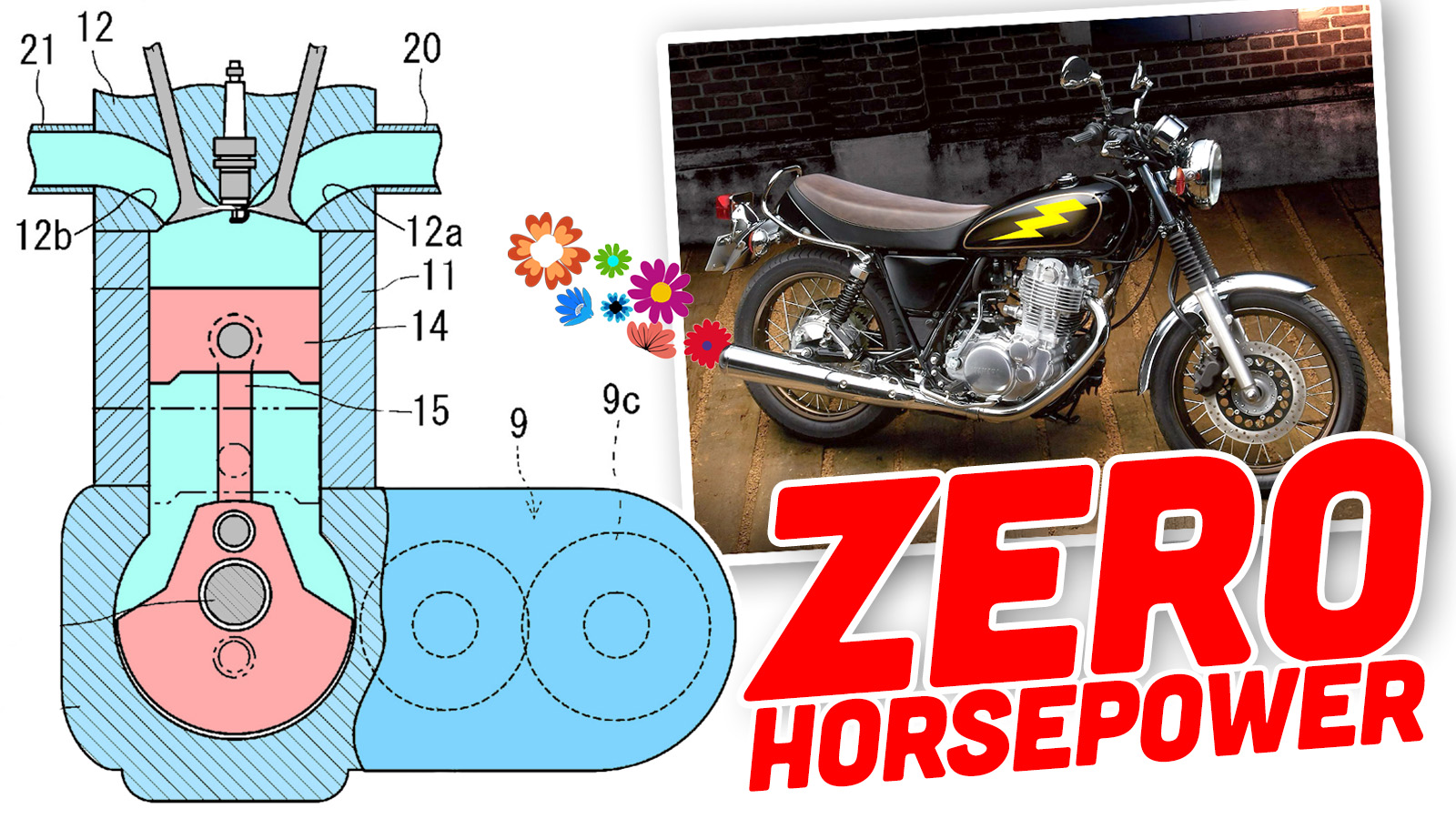





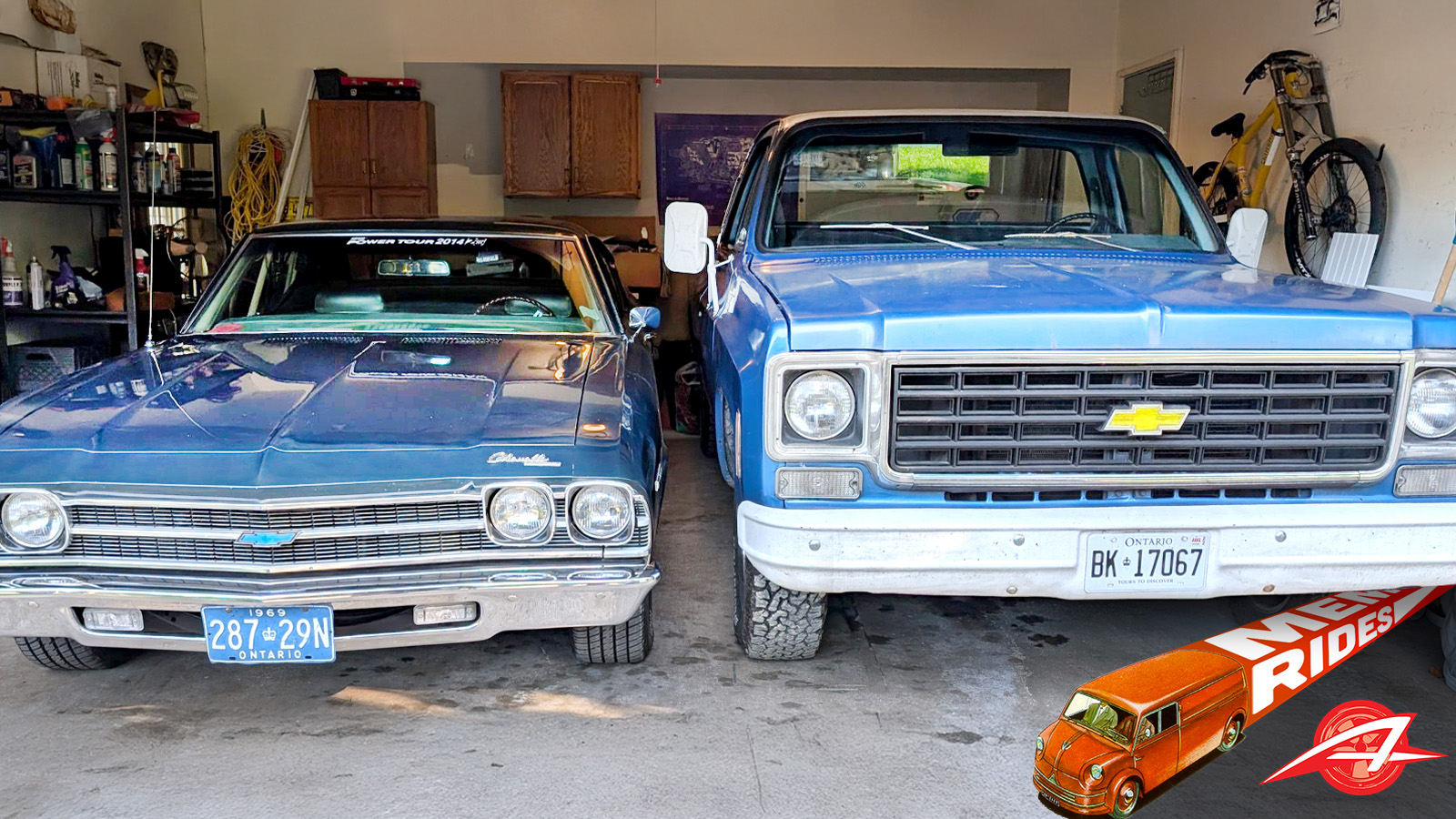
I hope this turns into a hybrid drivetrain.
Soooo… basically an wildly over complicated electric air compressor? Can you at least have an adaptor to fill the tires if needed?
Oh, that’s a great idea! Take the fake spark plug out and put your hose into the hole. 🙂
Didn’t the original Honda Insight work like this? It had a real, working engine, but for short distances, it could function as an EV by rotating the engine without injecting fuel.
An electric motor that makes noise and vibrations?
Hey, doesn’t your wife have one of those?
I should patent a straight six version of this to generate the noise without the vibration.
I disagree strongly with Steve about the noise. That’s not how an engine works. The exhaust note of your engine is large pressure pulses caused by hot expanding exhaust gases pushing out of the exhaust valve. Pushing cold not-expanding air out the intake valve will create very little exhaust noise, and you won’t hear much except some lame valve clatter.
How do I know? Because this isn’t a hypothetical situation. If you’re driving a diesel, and you lift off the accelerator to coast or engine brake, the governor(or ECU) completely stops injecting fuel and zero combustion occurs. When you do this, basically all the exhaust noise disappears and all you hear is some lame valve clatter.
Most EFI gas engines also completely cut fuel on coasting with similar results.
Yeah, but on an actual engine the exhaust valve opens at the start of the exhaust stroke. If you wanted expanding air to make noise you’d open the exhaust valve near the top of the exhaust stroke when the air would be compressed.
It use way more energy, but it’ll work.
You mean at the beginning of the power stroke I think.
You mean somewhere towards the end of it…
Maximum noise in the absence of fuel or ignition would be produced by the exhaust valve opening at the point of highest pressure. That would be at top dead center, which is the beginning of the power stroke.
Really if all you want to do is make noise, you would just use two strokes.
Reminds me of those Volks-Aire air compressor kit.
https://vwparts.aircooled.net/Volks-Aire-Air-Compressor-Kit-Standard-Model-DR3S-p/dr3s.htm
If they are running four strokes, then no, the exhaust valve would open on the exhaust stroke.
But as you point out below, two strokes would be much more sensible, if all they want is noise, because the compression and power strokes are just bouncing the piston off some air.
Also if all they want is noise the illustration of a cross flow head is a bit weird. They could just have a single valve for inlet and exhaust. A one valve head. Valve is open as the piston goes down, closes as it comes up and opens just before TDC.
And if they used a contained air volume linked to the crankcase they wouldn’t have to worry about oil mist and carbon emissions either. Or an air filter and exhaust system.
Steve is truly a world expert on exhaust sounds, so I don’t known if I’d say “that’s not how an engine works” to him, of all people.
Plus, look at the audio file I added to the post; that sounds similar to a revving engine. And so does a gas car when you downshift when coming to a stop — you can still hear the car “rev” when you downshift, but there’s no combustion happening.
Of course, the degree to which that sound differs from an engine in which combustion is occurring is certainly up for debate.
My experience with diesel engines is that engine braking, as opposed to merely cutting the fuel supply, is really loud.
Diesel engines generally have no throttles, so engine braking is accomplished by opening the exhaust valve on the power stroke, and that louder than running full power.
Some diesel engines have a strangle valve on the intake in case of runaway, but that’s not used in normal operation.
Physics and experience says otherwise. Look up videos of a spintron being used for testing though to see for yourself.
The headline is misleading. This isn’t a “0 horsepower” engine. It’s a negative horsepower engine.
You mean the topshot. And indeed, you are correct!
At least it sounds like there are enough practical “solutions” to make this more than a patent on model engines. Maybe this will keep other manufacturers from implementing a ridiculously complicated parasitic anti-engine on their motorcycles.
Then again, if the industry is set on doing something ridiculous…well, for example, I don’t think Ford’s patents on in-car ads and self-repossession are going to stop other manufacturers from taking up the ideas.
If the future is stupid, I guess they just won royalties on it. If not, I assume it was decent busywork for the company’s engineers.
so Yamaha is basically trying to use four-stroke engine as a musical instrument
Harley-Davidson built their ENTIRE BRAND off exactly that. It’s literally a part of an ICE’s allure. “Listen to that engine sing…” “here you can hear that v-12 as it comes off the corner…” “this engine is pure music…” have you ever been off a freeway and heard a sport bike ripping it up? Is that not pure bliss?? Motorsports race engine starts have been referred to as the orchestra or symphony coming to life. Fans have said they would not watch an EV drag race even if it could outrun a top fuel car. They’d rather have the slower with the sound. Since Yamaha is in the business of making music, why not use an ICE also lol?
maybe sometimes in the future we will get an instrument that are played like hurdy gurdy that produced crossplane inline-4 sound
So if I just put a bigger starter on the spouse’s already existing Yamaha bike…
Reminds me of how they used to put fake horse heads on the front of cars in the early days of the automobile.
I remember working for a small company (think the name was Shitequine) that would drive around leaving horse droppings in the street during the night in the 20’s
Honestly, if you’re going to have an almost-complete engine on there, why not just throw on a carb and fuel tank, or whatever, and get some kind of range-extender option? That way you can still get whatever cool sounds you’re looking for in normal, all-electric mode, but there’s actually some rationale behind having the engine, and a legitimate use case for it!
I completely enjoy the “saddle type vehicles” translation. Excellent.
Came down here for this. It has a distinguished “way of the horse and bow” ring to it, reminiscent of the ancient art of Hayabushido.
Most of the “Loud Pipes” crowd don’t strike me as EV Bike adopters.
Couldn’t you just put a baseball card in the spokes of the rear wheel and achieve the same result?
It worked great for me when I was six – my Schwinn sounded like a badass Harley, at least in my head.
Reminds me of this.
https://www.youtube.com/shorts/mcEDRHf3Knw
Why is there a spark plug in the drawings? This is all just deeply weird.
I searched all over the patent asking that same question. Either the fake engine has a fake spark plug, or they just used a generic illustration of a four-stroke engine to describe their fake engine.
I saw this the other day. I understand why you want noise HD is the safest bike on the road because of noise and kids especially on ebikes can be a bit scary silently darting around at night. But the vibration I don’t see it but I guess if you slap a fartteonic to a charger to suck power and make noise it foesnt need being the size of land yacht you can make a bike vibrate and suck power for something it doesn’t need too.
This has to be one of those “let’s patent this before somebody else does” ideas and not an actual “let’s actually manufacture this thing!” idea, right?
We can hope – but that also implies that they think this idea is good enough that someone would actually want to steal it
So, just add a wet shot of nitrous and an ignition system and you have a power boost on demand?
Someone’s going to spend a lot of time figuring out how to turn their noisemaker back into a functional engine…
Every time I think I have seen the dumbest thing ever, something dumber comes along. Can’t wait for the next lowest rung on this particular ladder.
Yeah, I just had to give the parts counter a VIN to buy one lug nut, this is dumber than that
At a dealership I can understand that – their inventory systems require it to look up the part in the computer (makes sure they don’t give you the wrong one – theoretically). But when NAPA wants a make and model to get me a roll of generic cork gasket material – that is where I draw this particular line. I would always tell them it was for a ’75 Matra Bagheera and blow their tiny little minds.
I guess, but its a 2023 RAM 1500 Classic, you’d think a Chrysler-Jeep-Dodge-RAM-Fiat dealer could just walk in the back and grab it out of a bin without any extra steps in the transaction
Probably not, because they still need to put it in the computer to charge you for it. And if the computer requires a VIN, you are putting in a VIN. I know for SURE that the system Mercedes uses can’t do anything without a valid VIN, and I would not be at all surprised if it’s the same one Chrysler uses for obvious reasons.
There’s no trim level at all that may use a different one? No inter-model year change where there’s a difference?
This is as pointless as the British bailing out Tata/JLR….
Harley’s attempt at a BEV failed. Yamaha obviously figures they could patent this and then sell it to them once Harley figures it out. The great thing is that it would mean that the Harley could make noise, no power, and leak oil to keep the brand ethos alive and well.
Oh snap, it would require most of the maintenance of a gas bike, wouldn’t it? Maybe longer intervals, but it’s going to need oil and at least a basic air cleaner.
I just don’t understand the desire to have fake engine sounds in any car. Tune your exhaust and intake to make a nice noise, or tune them to be very quiet if they sound bad. Speakers playing “coolcar.mp3” is weird right? double so for electric cars/motorcycles. Am I the one that doesn’t get it? that wouldn’t be the first time…
What a ridiculous idea. So you have to do oil changes on your noisemaker? Isn’t lack of oil changes considered a GOOD thing on EVs? This is nuts.
The good news is that, without combustion, your oil change interval should be pretty great. I bet you could even get away with keeping the same filter.
I wonder whether the waste heat generated mechanically will be enough to prevent condensation and rusting from humidity. Maybe the whole thing could be made from aluminum to prevent that.